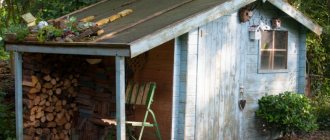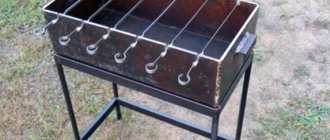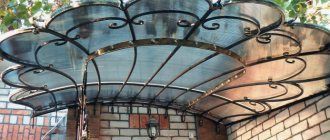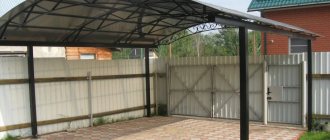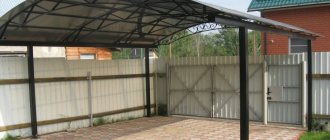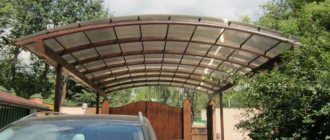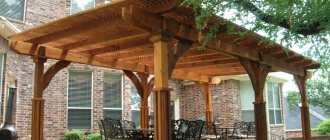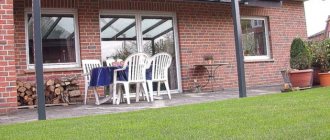Metal sheds are reliable, functional outbuildings, durable, practical, but visually light, fit harmoniously into the landscape of the site, and do not clutter up the natural landscape. In the article we will look at the advantages and disadvantages of metal structures, what is best to build from, we will offer examples of simple projects, and we will tell you how to correctly calculate the dimensions of a building, as well as its individual elements.
We will provide detailed, step-by-step instructions on how to make a lean-to canopy from a metal profile with your own hands; the example drawings were chosen with medium dimensions; if necessary, they can be adjusted to individual conditions.
Invalid Displayed Gallery
Calculation of a truss for a canopy
When calculating a truss for a canopy, it is important to be guided not only by the overall convenience of the location, but also by aesthetics, as well as the angle of the roof, the configuration of the roofing system and other parameters. You can prepare a drawing of a truss for a canopy, compare the planned dimensions with the territory and ease of access, correctly place the gate, think over the water drainage system and snow slopes
We will make a farm from a profile pipe. This is the most affordable material, easy to weld. We will learn the parameters of the profile pipe a little later, since they must be carefully calculated. To begin, determine the length of the overall metal structure.
The height of the ground to the ridge, as well as the type of roofing system, will depend on this.
The easiest way to equip a shed roof, but with this arrangement it is important to remember that the maximum step between two adjacent trusses should be no more than 1.75 m
Having determined the angle of inclination for yourself based on individual parameters, calculate the angle of inclination of the sheathing. On average, experts make it 30 degrees in the plane, or cut it at 45. This way the load will be distributed evenly.
No special calculation is required for canopies whose length does not exceed 30 m. But it’s also not worth saving, since when choosing rolled metal with thin walls, you cannot guarantee the rigidity of the welded parts. There will be vibration, and in the winter, due to snow, the metal frame may sag.
We propose to take a closer look at the preliminary calculation, having agreed that we will build a lean-to canopy, measuring 6 by 4 m. For strength, you should use a metal profile with a cross-section of 30 by 30 mm, with a wall thickness of at least one and a half mm. Having decided on the slope of the roof, we understand that the lower chord of the truss will be 4 m.
The top one will be about 4.5 m. First of all, it is necessary to arrange vertical guides from the same material. We make the largest side about 0.6 m, the smallest in fact, based on the calculated angle of inclination. Next, we divide the top row of the profile into equal parts.
We weld intermediate cross members to the lower part. These crossbars are also called diagonal lintels. They must be made of the same steel as the main frame. If you have the opportunity to save money, you can replace the crossbars with a pipe with a cross-section of 20 by 20 mm.
Previously, we said that with a single-pitch roofing system, you should choose a truss pitch of at least 1.75 mm. For greater reliability, we choose a step equal to 1 m. In total, about 5 similar trusses are suitable for 6 m. They should be mounted on pre-installed supports, then everything should be welded into a single unit, and then the polycarbonate should be secured using special jumpers made of a 20 by 20 mm profile.
Roof
The lightness of the profiled sheet (on average 5 kg per square meter) makes it an attractive material for arranging the roof of new country houses or those being reconstructed - the pressure of the finished structure on the foundation and walls in this case is minimal.
When installing corrugated sheets on the roof, you do not need to build a powerful rafter system. The high strength of the profile allows you to double the sheathing pitch, which makes construction based on corrugated sheets more economical.
You can fasten the material alone, without involving assistants in the process. The sheets have a significant area and are installed quickly and easily.
A roof made of corrugated sheets will become a practical and aesthetic protective element of any structure in the country, be it a country house or a garage.
Awnings diagrams drawings. Scope of application and construction of a canopy made from a profile pipe
Metal profiles today have become one of the most popular and sought-after materials for the manufacture of canopies of various types and types with polycarbonate coating, since its main advantage is its long service life. If such a building is properly cared for, it can last for decades. Such canopies can be used in a variety of places:
- in parking lots;
- in country private houses to create large covered areas;
- in various public places.
The scope of application of canopies made of metal profiles is quite extensive, since they are universal structures with a large number of different modifications.
The most popular today is the arched type of product. It is much more difficult to make than a single or double slope, but it looks very impressive. Such a canopy is built separately from the house or adjacent to its side.
When choosing the type of roof, it is necessary to take into account the fact that the snow does not linger on it, but falls freely to the ground, without creating a large load on the roof.
In addition, there are canopies of dome, arc, pyramidal shape, as well as single-pitched and double-pitched.
In addition to polycarbonate, slate or metal corrugated sheeting can be used to construct the roof. Therefore, we can say that the complexity of erecting a canopy from corrugated pipe directly depends on the choice of frame design and materials chosen for the roofing.
Application of metal profiles
Metal profiles are well suited for the construction of canopies for both commercial and recreational purposes. Recreational ones are used as protection from the sun and wind over swimming pools and playgrounds.
A utility shed is constructed in a place where a summer kitchen is installed, where household equipment is stored, or where a car is parked. The canopy structure can be free-standing or an extension of the house. In the first case, the canopy is erected on separate supports, and in the second, one or two sides rest on the wall of the house.
Single-pitch canopy
The easiest to install is a lean-to canopy. When erecting it, one row of supports is lower than the second, which is why the sheet of metal profile is mounted at an angle. Due to this roof design, the snow flows down without any hindrance.
There are other types of metal profile structures: gable, arched. In the first case, it will be more difficult to construct the frame and select more sheets of metal profiles to cover the roof. A gable canopy is often used to protect a large area from wind and rain. It is more resistant to adverse weather conditions.
To complete an arched canopy, you will need to use the services of professionals. It is quite difficult to make an arched structure yourself. Therefore, lean-to sheds are often installed.
Corrugated sheeting as a roofing material is often chosen due to its advantages:
- Environmentally friendly.
- Durability.
- UV resistance.
- Resistant to low temperatures.
- Durability.
- Strength.
- Reasonable price.
- Easy to care for.
- Fire safety.
In addition to all the advantages, corrugated sheeting can be easily installed with your own hands. You can build the structure without outside help, but provided that the canopy is small in size. A canopy made of metal profiles can transform the exterior of a house if its installation is carried out competently.
Most manufacturers offer a ready-made kit for assembling a canopy. It is enough to understand the finished drawings and assemble the frame using them. But this option will cost more than assembling a frame from separate profile pipes. In the case of the latter option, you will have to spend time selecting and trimming supports.
Sheds made of corrugated sheets
Greetings, my readers. In this article I decided to consider the topic of single-pitched sheds made of corrugated sheets. This material has excellent characteristics, the main ones of which are strength, lightness, frost resistance, durability - its service life is 50 years. That is why we choose it as a canopy covering.
A canopy is a structure on supports made in the form of a roof. According to their purpose, canopies protect the space underneath from precipitation and scorching rays of the sun.
Often there is a need to build a carport over the porch in a private house or country house. It is performed over counters on the street, barbecues, over recreation areas in the country, over ramps, ramps installed in stores for unloading goods from cars and in other cases.
The main elements of a lean-to canopy are posts, purlins - longitudinal and transverse, which are installed on them, and a covering - in our case, made of corrugated sheets.
Single-pitch canopies made of corrugated sheets are:
- Separately standing.
- Attached to the building.
It all depends on its purpose. These are easily and quickly installed structures. But everything is in order. Let's look first at free-standing lean-to sheds.
GOST
The process of erecting any building structures is regulated by current regulatory documents, canopies are no exception.
There are a lot of narrowly focused documents that interpret the requirements for the construction of these structures in different areas and industries. However, the basic conditions that cannot be changed or not complied with by the manufacturer are reflected in the following documents:
- GOST 23118 “Steel construction structures. Basic technical requirements"
- SNiP 31-01-2003 “Residential multi-apartment buildings”
- SP 31-107-2004 “Architectural and planning solutions”
Location of carport on a summer cottage
Before starting any construction work, you need to consider a place for the canopy. From the selected area you need to remove the turf to a depth of 12-15 cm, and then build a cushion of crushed stone and sand. In this case, you can build a slight slope, as well as drainage structures around the perimeter. Then you need to lay any parking covering on the pad. If the machine is too heavy, you can install a reinforced concrete screed.
Durable stone covering
Depending on the method of location on the site, the structures can be autonomous, and can also be used as an extension to a garage, bathhouse or utility block. Also popular are the galleries that connect the house and the gate.
Individual devices stand on metal or wooden supports. If the structure is adjacent to another building, then it may have the following support options:
- beam-supported, when one side is supported on a beam, and the other on supports;
- cantilever-supported - fastening is carried out using brackets or corners;
- the console version is recommended for small structures.
Console device option
Carport in front of garage
Now let's look at the options for garage canopies and the features of their construction. The most common option is when the canopy is placed in front of the garage door. It can be made for one or two cars. A similar structure can be built between the garage and the house. In the photo you can see the most popular ideas. Sometimes a combination of a garage and a carport is used.
Design option in front of the garage
When deciding how to make a lightweight canopy, you can place it on the side of the main structure. For the construction of the roof, materials such as metal profiles, pipes, and wooden beams are used. The roof can be made of polycarbonate, corrugated sheets or metal tiles. Part of the canopy can also be placed over the garage. Similar designs can be of the following types:
open ones have a common wall with the garage;
This is what an open structure looks like
closed ones have three walls. In this case, cladding is performed using wood, awning fabrics or lining. If necessary, the canopy can be covered.
Closed shelter
In addition, such buildings can be collapsible or stationary. Often a garage with a canopy is built under a gable roof; this option is recommended for a wooden frame. If the structure is arched, then you can use a metal frame with supports.
Garage or shed - which is better: the answer to this question depends on financial resources, the purpose of the structure and the materials used. The most convenient solution is a combined option.
Carports attached to the house: photo
An extension near the house is popular because adjacent structures are easier to install. You can also use a simpler mount. Before deciding how to build such a canopy and how to attach it to the wall, you need to understand the materials.
The frame for construction near the house is often made of wooden beams or metal pipes. Also, structures next to the house are made of brick or stone, and are also filled with cement supports.
Design option near the house
The design of a canopy in front of the house requires the presence of strong supports that can withstand the weight of snow falling from the main roof of the house. You can see how to make beautiful designs in the photo.
Any similar structure consists of a roof and a frame
Particular attention should be paid to the base. You can choose the following material:
The wood is easy to process and does not require any complex tools. But this material requires special care. Over time, the tree becomes covered with fungus, rots and cracks. It must be protected with special impregnations;
Spacious and durable wooden canopy
The steel profile pipe is installed using a welding unit. Such material can last a long time;
Steel elements
the combined option involves the use of cladding a steel frame with wooden slats.
Combined construction
For the roof, a more aesthetic solution is to use cellular polycarbonate, or you can also use a profiled sheet.
Features of carports for 2 cars
Using carports, you can build practical structures for two cars. When choosing a specific design for two cars, you need to choose the right dimensions. The photo shows the best options for such buildings. You can combine this design with a utility unit. The spacious structure for two cars has dimensions of 8 by 6. The standard width should be at least 2.5 meters.
Gable structure for two carports
Kinds
According to its design, the building has various methods of execution. It all depends on the purpose of the canopy, the material and the personal preferences of the owner. Today, you can build an extension in various ways, taking into account the selected material. Metal or wood can be used to construct supports. The roof frame is made in the same way. But you can see what wood-like metal siding looks like here.
The versatility of corrugated sheeting is that there is no need to adjust the ceiling to the fastenings
(It is also worth paying attention to how the pediment is covered with corrugated sheets). This is due to the fact that the edges of the sheet are concentrated very close and this is quite enough to fix the iron sheet
The cladding around the perimeter can also be different. The attached structure is open, trimmed with boards with windows, and presented in the form of a terrace.
But what kind of canopies and awnings there are over the entrance can be seen here.
In the video there is a canopy made of corrugated sheets adjacent to the house:
https://youtube.com/watch?v=RxbGI0EqdnM
Canopies made of polycarbonate can have different designs. The most common ones include:
- arched;
- single-pitched;
- gable.
The difference between them lies in the complexity of installation and the amount of material used.
But what types of polycarbonate carports there are, and how they can be made, this information will help you understand.
Arch
This polycarbonate canopy option has a rather attractive appearance. To attach it to a house, you need to have significant construction experience, because this design is distinguished by its complexity.
Canopy arch made of corrugated sheets adjacent to the house
They arise for the reason that the roof straps to which the corrugated sheeting is to be fixed must be presented in a curved shape. And to obtain such a bend, special equipment is used.
Single-pitch canopy
This type of corrugated sheet extension does not require special experience or the use of special equipment
But at the same time, increased attention will be required when choosing the correct angle of inclination of the roof.
Single-pitch canopy
Thanks to it, the canopy will not be subject to constant accumulation of snow in winter, and the sheathing will be freed from unnecessary pressure. A polycarbonate canopy over a porch can look exactly the same.
bbb77658765d88a0938f3bf98f404168.jpe
Gable canopy
This design is a full-fledged roof. To obtain such a canopy, one corrugated sheet will not be enough. A gable roof can be used when a spacious open-type summer kitchen is required. There is also another roofing option - multi-slope. This type of construction is the most difficult to implement. Only professional builders can make it.
Gable canopy
If we talk about the dimensions of the canopy, then their choice should take into account the load and purpose of the structure. The canopy adjacent to the house should not be large, otherwise the wall will not be able to withstand the load. If this canopy is over the porch, then it should not be very small. But the carport is calculated taking into account its size. But you can see what the texture of the wall looks like under the plaster here.
If the car is small, then it can fit under a structure of at least 2.3 x 5.5 m. For an SUV or truck, you will have to find a load with dimensions of 3.5 x 6.6 m. It is also worth considering the height of the canopy. The optimal parameter is 2.3 m. But for a gazelle this will not be enough. As the height of the canopy increases, the likelihood of rain and snow getting under the extension increases.
Maybe
How to do it yourself?
Step-by-step instructions, which describe how to choose a place, weld a canopy and install a roof, are very important for beginners. Experienced people can get by without it, but those who are building a shed for the first time have a lot to learn before getting started.
Selecting a location
Before you begin installing the canopy, you should decide on the location where this extension will be placed. Experts recommend refraining from building structures in lowlands. If there is no other place, then you will have to make a storm drain, which will entail additional financial investments. It should also be noted that the canopy should protect from sunlight throughout the day. Perhaps for this you should change the degree of inclination of the visor.
The next step is high-quality drawings of the canopy. Calculations should be made not only on the size of metal structures, but also on the cross-section of the profile material. Basically, for frames up to 6-7 meters in length, a 60×60 section is chosen; if the size exceeds the above length, then a pipe with a section of 80×80 is suitable.
Installation of supports and sheathing
After a suitable location has been selected, they begin installing the supports according to the finished scheme.
It is extremely important to install them smoothly and efficiently, otherwise the frame will not last long. To check the correct position of construction supports, use a level
Next, the racks are concreted and left for several days for the concrete to harden. During this time, the sheathing is assembled or welded. To do this, use a metal profile or profile pipe. Wooden beams are also used, but much less frequently.
The sheathing performs an extremely important function. The stability and safety of the entire canopy directly depends on how correctly this structure is installed. If everything is calculated and installed correctly, the roof will be able to withstand even the most severe snowfalls and downpours. The entire installation can be easily done with your own hands, without involving specialists. A lathing built independently can provide a long service life only with careful calculation and a high-quality approach to all work.
If the choice fell on wooden sheathing, then when choosing boards you should pay attention to some factors:
- boards and beams should not be wet;
- the best types of wood that are used for corrugated sheeting are considered to be coniferous;
- To avoid damage by fungi and various microorganisms, the wood must be treated with an antiseptic.
When choosing lathing from a profile pipe, the most important thing is its strength. In order to ensure the endurance of all load-bearing parts, you should choose a pipe with the most minimal dimensions. The optimal cross-sectional parameters for such elements are 40×20 mm. Absolutely all metal is treated with anti-corrosion agents.
Roof installation
In order to find out the amount of roofing material, you first need to calculate the entire surface area that should be covered. The resulting figure should be increased by 5-7%. Corrugated sheeting is recognized as the most popular material for canopies. This is a corrugated sheet that is coated with a polymer shell and zinc. It is not afraid of temperature changes, corrosion and rust, does not require maintenance, has a variety of colors, is environmentally friendly and does not ignite.
It is divided into three main types: load-bearing, wall and roofing. Experienced craftsmen advise using load-bearing corrugated sheeting rather than roofing sheeting in the construction of frames, since it is distinguished by its increased rigidity and is able to withstand heavy loads (for example, snow). The finishing touch is to secure the selected sheets. For this you will need self-tapping screws
The corrugated sheeting should be laid very carefully so as not to damage the polymer shell. The overlap is performed in one wave
To learn how to make a canopy from a metal profile with your own hands, see the following video.
Manufacturing of sheathing
A wooden sheathing is placed on the trusses, on which the roofing covering is installed. The easiest and most reliable way is to lay a simple metal profile flooring. It is reliable, quite durable, and relatively inexpensive. The use of polycarbonate sheets for the manufacture of canopy roofing is also widespread today. In addition, no one has canceled slate, and you can also use sheets of polymer. To ensure that wooden sheathing lasts longer, wooden structures should be treated with antiseptic preparations. The polycarbonate roof is laid directly over the girders of the truss.
Selection of materials and preparation of tools
The main requirement for the quality of profile pipe products is strength. To ensure the stability of the load-bearing parts of the structure made from them, you need to select pipes with minimum parameters equal to 80x80 millimeters. For additional elements, the optimal cross-sectional size will be 40x20 millimeters.
To determine the amount of roofing material, first calculate the area of the surface to be covered, and then increase the result obtained by 5%. Fastening is carried out with roofing bolts and special gaskets.
The structure is assembled in one of the following ways:
- Welding. But for this you need not only to have a welding machine with electrodes, but also to know how to properly weld a canopy from a profile pipe. Without skills, such work cannot be done.
- Using threaded connections. This requires metal corners and mounting bolts.
- Using special clamps.
A do-it-yourself canopy costs much less than a purchased one. It will meet the requirements subject to strict adherence to the technology of its construction.
Preparatory work
To successfully complete the task, it is necessary to draw up a rough sketch of the future canopy, prepare tools, purchase consumables and accessories. Required tools:
- building level and tape measure;
- grinder or saw for cutting metal;
- drill with a hammer drill and a set of drills and bits;
- riveter;
- metal screws or rivets.
A complete and objective assessment of the amount of consumables, as well as the required volume of fastening devices, depends on a clear drawing up of the drawing, so the preparation of this document should be treated with special attention. In addition, do not forget about safety precautions when working with metal products.
Dimensions and drawings
Option drawing of a canopy made from a profile pipe
First of all, you need to create a sketch. For example, let’s take a canopy whose roof will be made of polycarbonate. The sketch must show the appearance of the future structure and its approximate dimensions. Then you need to take all measurements at the site where the structure will be installed and create a detailed drawing. The canopy can be built either free-standing or attached to the house.
For example, you have a house 9x6 meters, and in front of it there is a free space of 9x7 meters. In this case, the width of the canopy can be equal to the width of the house wall, i.e. 9 meters. The reach can be made, for example, 6 meters. Thus, a canopy measuring 9x6 meters is obtained.
It is optimal to make a low paradise 240 centimeters high, a high one - 350–360 centimeters.
Simple mathematics calculates the angle of inclination. In this case it is equal to 12–13 degrees.
Now that all the measurements have been made, you can create a drawing. Rafter trusses must be shown on a separate drawing.
Roof truss options
After all the preparatory paper work has been done, you can calculate the required amount of building materials. Always purchase them with a margin of at least 5 percent. This is necessary in case you come across defective products or damage something during the process.
Scheme
If you decide to make a metal canopy, then the provided diagram can help you in making a structure suitable for you:
Metal structure drawing
Roof truss drawing
Scheme of a lean-to canopy
Metal canopy diagram
Scheme of a gable canopy
Working drawing of the canopy
Arched canopy diagram
Carport
Canopy drawing
«>
Construction tips
Any construction includes a whole range of works. This includes the purchase of materials, the selection and preparation of a site for installation, the engineering calculation of a canopy made from a profile pipe, and of course the assembly process itself.
Gable roof.
Preparatory activities
If you have several options for placing a canopy, you should first decide on the location. It is better to place such structures on a hill or on a relatively flat surface, where it is easy to arrange drainage. Water will collect in the lowlands, hence the additional costs for storm drainage.
A preliminary drawing of a canopy made from a profile pipe must be made
In addition to the location of the structures themselves, it is important to take into account the cross-section of the pipes. So, in the case when the length of the building does not exceed 4 - 6 m, and the width fluctuates around 3 - 4 m, for racks it is enough to take a pipe with a cross section of 60x60 mm
For a larger quadrature, a section of 80x80 mm is used.
The simplest drawing of a canopy made from a profile pipe.
The top frame, on which the trusses for the six-meter canopy will be based, is made from a 40x25 profile. The pipe for arches and cross trusses is selected depending on the amount of precipitation in the area. For courtyard structures with a small square footage, as a rule, products with a cross section of 30x30 mm are sufficient.
The material from which it is planned to construct the roof plays a big role here. For curved arched roofs, it is currently advisable to use lightweight, translucent cellular polycarbonate. It is better to make a straight single or gable canopy in the barbecue area from a fireproof metal roofing sheet or cover it with slate. Naturally, the heavier the material, the thicker the structures should be.
Roller pipe bender.
Canopy installation
Any work of this kind begins with marking and installing support columns. It is recommended to install supporting metal columns for light structures in the yard or at the dacha in increments of about 2 m. If the spans are larger, then the cross-section of the pipes will need to be increased, and the price will naturally increase.
Demountable connection.
Holes for installation are conveniently and quickly made using a garden drill with a diameter of 300 mm; a depth of 60 cm is sufficient. When all the holes are ready, the bottom of them must be compacted well, otherwise the column may shrink.
Before installation, a gravel or sand base 50 mm thick is filled and compacted at the bottom, after which the column can be installed and filled with concrete. All columns are mounted strictly level or using a plumb line. It is better to carry out such work with an assistant, since there is a high probability of making mistakes alone, and when the concrete sets, it will no longer be possible to correct it.
Straight trusses from profile pipes.
Concrete is poured to the level of the beginning of the pit for the construction of the screed. The floors under the canopy, depending on the financial capabilities and purpose of the structure, are laid with paving slabs or a concrete screed is made.
In both cases, you will need to make a small pit. To do this, the soil is selected to a depth of 100–150 mm, after which the surface is leveled and compacted. If paving slabs are being laid, it is recommended to cover the surface with geotextiles to prevent grass from breaking through.
To arrange the sole, you can use sand or gravel. The filling is done to a level of 50 mm and is also compacted. This layer is necessary to ensure normal drainage.
Next, the reinforcement frame is laid and a layer of concrete 50 mm thick is poured. This screed can withstand loads of up to 3 tons.
Covered parking on 4 pillars.
On top of the columns, a strap is made around the perimeter of the canopy. The transverse trusses for the sloping roof will be based on this horizontal frame. For a straight single or gable roof, trusses are installed in increments of 800 mm. The installation pitch for a curved roof varies depending on the width of the polycarbonate sheets, but, as a rule, it is about 500 mm.
The video in this article shows some of the intricacies of installation.
Installation of supports
The metal profile should be cut according to the number of support posts; their length should be 3 m. Depending on the type of structure you choose, the method of attaching the posts is determined. When constructing a stationary canopy, the supports are leveled and concreted, but when constructing a mobile analogue, additional cutting of metal pipes with a diameter slightly larger than that of the support pipe and a length equal to the depth of the foundation is required. The prepared metal sections are mounted in pits and filled with cement mortar. Then a profile is inserted into each of the pipe scraps. Holes are drilled in the pipe and profile and the entire support is bolted together.
Roof installation process
To add rigidity and prevent premature destruction, you can use the described protective “casings” when arranging a stationary structure. The only difference from mobile awnings will be that the profile must be welded to a metal pipe.
Tips for choosing a quality profile
Before erecting any structure, you should decide on the choice of material. When purchasing a metal profile or pipes, you should carefully inspect the workpieces to see if there are any cracks, cavities, sagging, inconsistencies along the seams, or a large number of dented and bent workpieces. When purchasing galvanized materials, it is advisable to check the quality of the coating - whether there are any peelings or sagging.
When purchasing, you must request a copy of the certificate and a receipt. It is imperative to ensure that the pipe wall thickness corresponds to that stated in the documents. You can’t make pipes in a garage on your knees, and there are no fakes, but you can come across poor quality material, so it’s better to buy in fairly large stores.
Online calculator for pitched roof
This calculator will simplify the selection of materials for the rafter system and the final roofing covering, and will allow you to calculate the angle of inclination of the slope, the amount of sheathing and the size of the rafters.
Before making calculations, it is strongly recommended:
- Study the features of the rafter system for a specific roofing material. To a greater extent this applies to the sheathing. So, for bitumen shingles, the sheathing must be solid (the board can be replaced with sheets of OSB or plywood). For metal tiles, the lathing is installed taking into account the size of the wave.
- Check the reliability of the selected rafter angle and pitch. The program “Rafters 1.0.1.” will help with this.
Calculation results:
Roof angle: 0 degrees.
Design Features
A canopy is a small architectural form, part of a covered area that has a functional or decorative purpose. The main function of this structure is to protect the site from precipitation and sun.
Metal profiles compare favorably with other materials in their resistance to biological, chemical, and mechanical influences. Corrugated pipes with a square or rectangular cross-section are easy to design and install. They are equally well suited for installing a small canopy for a porch and creating a spacious covered area.
The canopy consists of:
- foundation;
- supports or suspensions - vertical and inclined load-bearing elements of the frame;
- lateral connecting elements - slopes and trusses;
- rafter system, consisting of rafter legs, trusses, sheathing;
- roofs.
In the case of erecting a canopy over a small area, for example, a porch or a sandbox, you can do without trusses - the structure will fully withstand snow and wind, since it will not have long horizontal sections.
If you plan to install a canopy over a parking space or a swimming pool, the horizontal ceilings and rafter legs will be longer. Such extended elements are vulnerable to load. To distribute it and give rigidity to the structure, in these areas they use not individual pipes, but trusses (reinforced structural parts consisting of two pipes and vertical and inclined elements connecting them - racks and braces).
The foundation for a canopy is most often made columnar, since its equipment does not require large excavations. The roof is made of polycarbonate, corrugated sheets, ondulin and other sheet materials.
Definition
Metal canopies are simple stationary or mobile street-type building structures that serve as a protective structure or a decorative element of the exterior. The main structural elements of this type of building are the roof, consisting of a frame and waterproof roofing material, and strong supports, which in some cases can be replaced by a wall.
Photo of a metal canopy
In the general understanding, this is a shelter from bad weather, ultraviolet radiation and other natural influences. However, in addition to their protective function, these structures can complement the architectural design of the building from an aesthetic point of view.
How to build a canopy with your own hands?
To make a canopy from corrugated pipe with your own hands, the first step is to prepare the area. It should be cleared of debris and large stones. Then the territory is marked according to the drawing. Holes for racks are drilled or dug. The diameter depends on the size of the structure, and the depth is up to 1 m. The higher the groundwater, the deeper the pillars should be buried. Each rack is poured with concrete. The installation of supports is preceded by work to fix each of them according to the level strictly vertically.
To install the roofing elements on the pillars, mark the position of all crossbars, etc. After this, they proceed to the manufacture of trusses and horizontal lintels. First, all the elements are cut and then welded together in the required sequence. Everything is assembled in accordance with the drawing.
When the entire structure is assembled, they move on to finishing work. The joints are cleaned, the entire structure is coated with a primer to protect it from corrosion, and lastly it is painted. After installing the frame, they proceed to laying the roofing material. It should be taken into account that on each side it protrudes by at least 20 cm. If necessary, the joints are treated with sealant.
The installation of a gable and hip roof differs only in the installation of the ridge. To make an arched canopy, you need a pipe bender, as well as the ability to make equally curved elements. Otherwise, the design will turn out to be asymmetrical.
Welding method. Welded or bolted.
For a do-it-yourself metal canopy, there are two ways to assemble it. By bolting or welding. The second is preferable, since the structure is stronger. It is better to perform welding in a carbon dioxide environment or its mixture with argon.
Only very simple configurations can be made with bolts, but they will not be particularly reliable. Such structures are often sold ready-made, which are assembled at the installation site.
